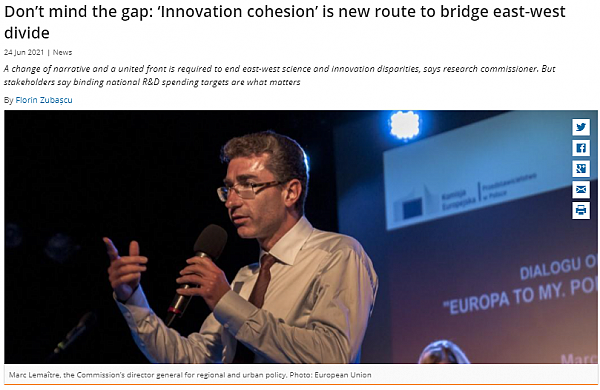Press Don’t mind the gap: ‘Innovation cohesion’ is new route to bridge east-west divide
The EU no longer aims to bridge the innovation gap in Europe, but to promote “innovation cohesion”, the EU commissioner for research and innovation told the European Commission’s annual research policy conference.
That will require member states to acknowledge the shared goals of EU R&D policy and the effort needed to create the European Research Area (ERA) single market for research.
These objectives require a united front that leaves no countries or regions behind, said Mariya Gabriel. “It’s time to change our narrative,” she told the Commission’s research & innovation days conference on Wednesday. “We need to work for a European innovation ecosystem where all our talents have access to quality information, to funding, and they can build networks.”
Change is needed as Europe is enters a fourth wave of innovation, which must be underpinned by a “coherent and operational” strategy for fostering the growth of deep tech start-ups. “We can be a real global leader in this field, so I think that we need to seize this momentum,” she said.
The EU should shift towards a new innovation strategy, said Gabriel. “I think that we should seize the momentum to transform Europe into a global powerhouse in the new wave of innovation.”
To support this, the Commission is working on a new system of governance for ERA and a new pact for research and innovation that will chivvy member states to increase national investment in R&D and support the careers of researchers.
Stakeholders are not impressed, saying plans to revamp ERA and reduce the research and innovation divide in Europe need binding national R&D spending targets.
Kurt Deketelaere, secretary general of the League of European Research Universities said the plans will have little impact if member states don’t sign up to binding targets. For over 20 years, EU countries have been encouraged to raise R&D expenditure to 3% of the GDP, but very few have done so.
“We really have to take action,” said Deketelaere. “Action means commitments, and commitments very often mean legally binding stuff.”
“I think it's really the time that we oblige member states to put their cards on the table, and to make sure that, at the end of the day, things are happening,” Deketelaere said.
Norbert Lütke-Entrup, chair of Business Europe’s working group on research and innovation, said simply wishing for a 3% target would not make it happen. “We've tried it before. It didn't work,” said Lütke-Entrup. “I'm not really sure that I now see a different situation or a strong reason why it should be different this time.”
Car manufacturers are increasing R&D investments as demand for electric vehicles grows. Germany and other countries with strong automotive industries are closer to the 3% target, but others need to follow suit. “We have other new technologies, artificial intelligence, 5G networks, industry 4.0, so there is no shortage of investment opportunities,” said Lütke-Entrup.
Research fueling recovery
To mitigate the effects of the coronavirus pandemic, the EU is pulling together a €672.5 billion recovery fund. Member states can spend their share according to national investment plans that must be agreed with the Commission. Commission officials estimate research and innovation projects represent between 4 and 13% of the grants requested by member states in their recovery plans.
Gabriel said €35 billion from the recovery fund will be invested in research and innovation. Separately, €5 billion from the recovery fund was added to the Horizon Europe budget.
“Our analysis shows there will be important investments in innovation,” she said. Gabriel hopes R&D investments of any kind will help narrow the innovation performance gap between EU member states.
Earlier this week, the Commission released the 2021 Innovation Scoreboard,, showing several countries in southern and eastern Europe have improved their R&D performance, slightly narrowing the gap with richer member states in western and northern Europe. However, excellence in research and innovation remains concentrated in northern and western Europe.
Marc Lemaître, the Commission’s director general for regional and urban policy, said the data are positive but the innovation gap, “is still very present in Europe - and still wide.” Less-developed regions in Europe represent a quarter of the EU’s population, but only 5% of R&D expenditure in Europe, Lemaître noted.
“It is clear that because of this innovation divide, Europe is not firing on all its cylinders,” said Lemaître. That puts Europe at a competitive disadvantage against South Korea, Japan and the US. “If we tackle the innovation divide we will be better equipped to close this gap,” he said.
Portuguese MEP Maria da Graça Carvalho said the EU should make sure that member states use all funds available, including the recovery fund and cohesion policy funds. “One of the conditions to narrow the gap is that we have more investment in research and innovation,” she said. “We have to make sure that the member states invest more.”
